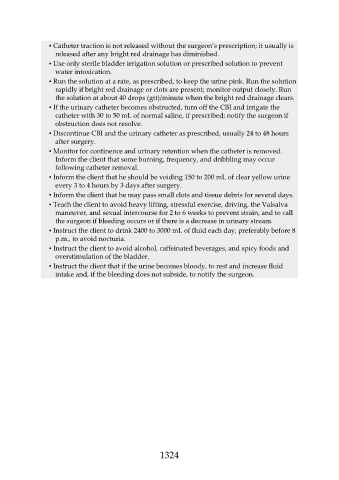Page 1324 - Saunders Comprehensive Review For NCLEX-RN
P. 1324
▪ Catheter traction is not released without the surgeon’s prescription; it usually is
released after any bright red drainage has diminished.
▪ Use only sterile bladder irrigation solution or prescribed solution to prevent
water intoxication.
▪ Run the solution at a rate, as prescribed, to keep the urine pink. Run the solution
rapidly if bright red drainage or clots are present; monitor output closely. Run
the solution at about 40 drops (gtt)/minute when the bright red drainage clears.
▪ If the urinary catheter becomes obstructed, turn off the CBI and irrigate the
catheter with 30 to 50 mL of normal saline, if prescribed; notify the surgeon if
obstruction does not resolve.
▪ Discontinue CBI and the urinary catheter as prescribed, usually 24 to 48 hours
after surgery.
▪ Monitor for continence and urinary retention when the catheter is removed.
Inform the client that some burning, frequency, and dribbling may occur
following catheter removal.
▪ Inform the client that he should be voiding 150 to 200 mL of clear yellow urine
every 3 to 4 hours by 3 days after surgery.
▪ Inform the client that he may pass small clots and tissue debris for several days.
▪ Teach the client to avoid heavy lifting, stressful exercise, driving, the Valsalva
maneuver, and sexual intercourse for 2 to 6 weeks to prevent strain, and to call
the surgeon if bleeding occurs or if there is a decrease in urinary stream.
▪ Instruct the client to drink 2400 to 3000 mL of fluid each day, preferably before 8
p.m., to avoid nocturia.
▪ Instruct the client to avoid alcohol, caffeinated beverages, and spicy foods and
overstimulation of the bladder.
▪ Instruct the client that if the urine becomes bloody, to rest and increase fluid
intake and, if the bleeding does not subside, to notify the surgeon.
1324

